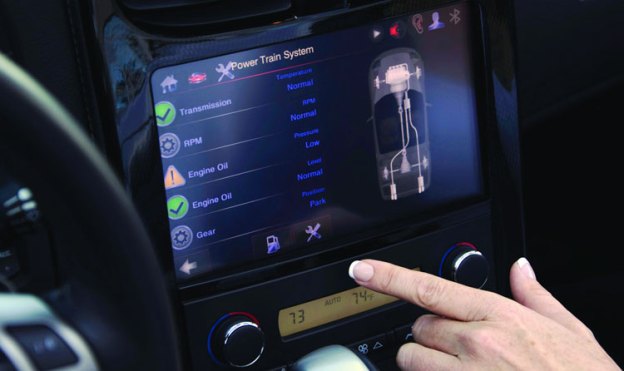
Freescale is one of the biggest processor companies that we hardly ever talk about. I’m at the Freescale Technology Forum this week, but I really had no idea just how deeply the company penetrates the automotive and appliance markets. Freescale processors can be found in connected cars, connected appliances, e-readers, and non-Apple tablets (mostly in Asia). Looking at the demonstrations and connecting the dots, the firm is advocating a near-term future that could be amazing.
Of course at the same time I’m reading a science fiction novel on my Kindle DX called Robopocalypse a Terminator-like story where a hostile artificial intelligence created by humanity decides to use connected devices to wipe us out. So I’m having this kind of “oh cool connected devices… oh crap” moment.
Let’s talk about some of the cool stuff at the show.
 The smart suspension
The smart suspension
One of the coolest things at the show is the Michelin active suspension system, which fits entirely inside a wheel. Active suspension doesn’t yet exist on a car today, but advances in computing are bringing it closer to reality. Rather than using shocks that merely dampen the force of passing over uneven ground, an active suspension senses bumps and lifts the wheel over them. Rather than anti-sway bars, the computer puts pressure on the wheel to keep the car from tipping. The result is a vastly smoother and better handling car. It isn’t a hover car yet, but it should ride like one, and corner far better (if you’ve ever been on a hover craft, they don’t corner well at all, they drift sideways into things, but man are they smooth).
Motorcycle airbags
I used to ride a motorcycle. I kind of miss doing that, but the issue is I’m kind of my entire business, and I can’t afford to spend quality time in a hospital. (If you’ve ever ridden you learn two things: Folks in cars don’t see you and, for some crazy reason, you don’t care. However if you hit a car or one hits you you’ll care, very suddenly, a lot. “Mommy was that a speed bump?…No that was a motorcycle dear.”) Well, at the show they have an airbag vest for motorcycle riders. Like an airbag it inflates rapidly to protect your neck and body. Unlike car airbags, this one won’t instantly break your nose or knock you out (wait till you experience a car airbag in real time).
Control your car with your tablet
The show also featured both a Volt and a QNX-sponsored Corvette that showcased things like a tablet interface where you could check the embedded cameras (to see if someone was messing with your car or your kid was doing something with it they shouldn’t), check car diagnostics, or control some features by remote (start it, unlock the doors, honk the horn, or roll down the windows). I’m thinking of wonderful ways to freak out my wife. Some of the newer cars allow you to do some of this from a smartphone today.
Home automation made practical
Atheros (a part of Qualcomm) showed off a new very low-power Wi-Fi radio that could be put in battery-powered devices like remote thermostats for your heating and cooling system, or to control your garage door opener and report its status. Wouldn’t it be nice to be able to check and close your garage door if you’d left it open on the way to work, or from your bed? You can do that now, but it’s kind of a mess to set it up, and this technology would make networking things work without wasting a lot of power or even requiring a power plug.
 Food for the imagination
Food for the imagination
Freescale is supplying the processing power for some of the smart refrigerators on the market. These allow you to better manage the contents of the fridge, and likely substantially reduce the chance that something growing in the thing will eventually take over the world, or at least smell up the house. Tied to an online service, they would automatically order what you needed before you knew you needed it.
Coming soon: Real robotic helpers
One of the keynotes had a small robot as a presenter, which was rather impressive. It has realistic fingers, human-like motion, and a rather impressive sound system. Designed to be a helper for those who are disabled, it was a rather remarkable demonstration of how far sensors and motors have advanced, making it look like we are single-digit years before we could all have a little helper around the house that wouldn’t want a raise in their allowance before actually helping.
Computerized humans
Later in this same keynote, they showcased nanotechnology biomedical devices that would interface humans with electronics. Yes, for you singularity folks, this is another step in that wonderful or scary (depending on what side you are on) direction. But it could do amazing things to identify physical threats (think of a sensor on your tooth that could identify pathogens, or toxins – no more Montezuma’s revenge). Or think of interfaces with prosthetics that could allow people who currently can’t walk to walk again.
Wrapping up
I’m just touching the surface of what is being demonstrated at this show. From a multitude of different sensors which can translate the real world into a digital model, to a wealth of tablet and e-reader products and prototypes in all shapes and sizes, to an injector system for NASCAR which could be used to help solve concerns surrounding security on these new connected cars, the Freescale Technology Forum is a showcase of dreams. My hope is I can maintain this positive feeling at least until I read the next chapter of Robopocalypse.




